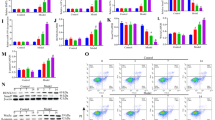Abstract
Objectives
To investigate the role of microRNA-145, that regulates gene expression of genes related to differentiation, proliferation and the phenotype of smooth muscle cells (SMCs), in the differentiation of human bone marrow mesenchymal stem cells (hBM-MSCs) to SMCs.
Results
Real-time PCR analysis indicated significant upregulation of SMC markers, including SM-α-actin, calponin, caldesmon and SMMHC, in SMCs compared to hBM-MSCs. Conversely, Krüppel-like factor 4, the direct target of microRNA-145 and the suppressor of smooth muscle differentiation, was suppressed in hBM-MSC-derived SMCs. Western blot analysis and immunocytochemistry also confirmed that the introduction of microRNA-145 into hBM-MSCs induced mature contractile SMCs. The functionality of hBM-MSC-derived SMCs was assessed by proliferation assay using PDGF-BB and contractility assay using carbachol. The results showed that the produced SMCs contracted in response to carbachol stimulation.
Conclusion
Overexpression of microRNA-145 in undifferentiated hBM-MSCs results in functionally mature contractile SMCs that can be used in drug discovery and cell therapy in SMC disorders such as vascular disease.






Similar content being viewed by others
References
Beamish JA, He P, Kottke-Marchant K, Marchant RE (2010) Molecular regulation of contractile smooth muscle cell phenotype: implications for vascular tissue engineering. Tissue Eng Pt B Rev 16:467–491
Chen S, Lechleider RJ (2004) Transforming growth factor-β-induced differentiation of smooth muscle from a neural crest stem cell line. Circ Res 94:1195–1202
Cheng Y, Liu X, Yang J, Lin Y, Xu DZ, Lu Q, Deitch EA, Huo Y, Delphin ES, Zhang C (2009) MicroRNA-145, a novel smooth muscle cell phenotypic marker and modulator, controls vascular neointimal lesion formation. Circ Res 105:158–166
Cordes KR, Sheehy NT, White MP, Berry EC, Morton SU, Muth AN, Lee TH, Miano JM, Ivey KN, Srivastava D (2009) miRNA-145 and miR-143 regulates mooth muscle cell fate and plasticity. Nature 460:705–710
Danielson LS, Menendez S, Attolini CS, Guijarro MV, Bisogna M, Wei J, Socci ND, Levine DA, Michor F, Hernando E (2010) A differentiation-based microrna signature identifies leiomyosarcoma as a mesenchymal stem cell-related malignancy. Am J Pathol 177:908–917
Gong Z, Niklason LE (2008) Small-diameter human vessel wall engineered from bone marrow derived mesenchymal stem cells (hMSCs). FASEB J 22:1635–1648
Jafarian A, Taghikani M, Abroun S, Allahverdi A, Lamei M, Lakpour N, Soleimani M (2015) The generation of insulin producing cells from human mesenchymal stem cells by MiR-375 and Anti-MiR-9. PLoS One 10:e0128650
Kingston RE, Chen CA, Okayama H, Rose JK (1996) Calcium phosphate transfection. In: Taylor GP (ed) Current protocols in molecular biology. John Wiley & Sons, Inc., New York, pp 9.1.1–9.1.11
Pittenger MF, Martin BJ (2004) Mesenchymal stem cells and their potential as cardiac therapeutics. Circ Res 95:9–20
Yamaguchi S, Yamahara K, Homma K, Suzuki S, Fujii S, Morizane R, Monkawa T, Matsuzaki Y, Kangawa K, Itoh H (2011) The role of microRNA-145 in human embryonic stem cell differentiation into vascular cells. Atherosclerosis 219:468–474
Yang B, Guo H, Zhang Y, Chen L, Ying D, Dong S (2011) MicroRNA-145 regulates chondrogenic differentiation of mesenchymal stem cells by targeting Sox9. PLoS One 6:e21679
Yang L, Geng Z, Nickel T, Johnson C, Gao L, Dutton J, Hou C, Zhang J (2016) Differentiation of human induced-pluripotent stem cells into smooth-muscle cells: two novel protocols. PLoS One 11:e0147155
Acknowledgments
The authors acknowledge the support from the Research Council of Tarbiat Modares University and Stem Cell Technology Research Center (Tehran, Iran) for providing the necessary facilities and funds for this research work.
Supporting Information
Supplementary Table 1—Primer sequences used in the quantitative real-time PCR.
Author information
Authors and Affiliations
Corresponding author
Ethics declarations
Conflict of Interest
The authors declare no financial or commercial conflict of interest.
Electronic supplementary material
Below is the link to the electronic supplementary material.
Rights and permissions
About this article
Cite this article
Pajoohesh, M., Naderi-Manesh, H. & Soleimani, M. MicroRNA-145-based differentiation of human mesenchymal stem cells to smooth muscle cells. Biotechnol Lett 38, 1975–1981 (2016). https://doi.org/10.1007/s10529-016-2177-1
Received:
Accepted:
Published:
Issue Date:
DOI: https://doi.org/10.1007/s10529-016-2177-1




